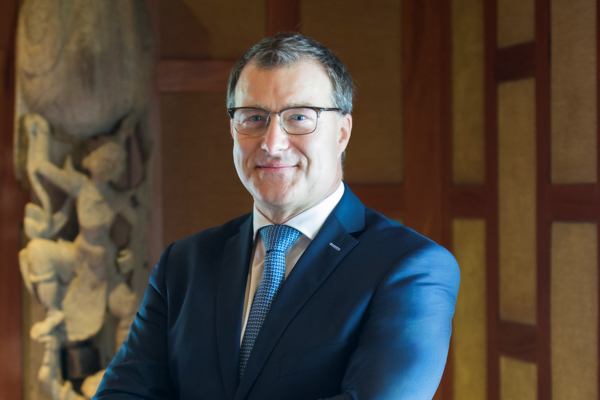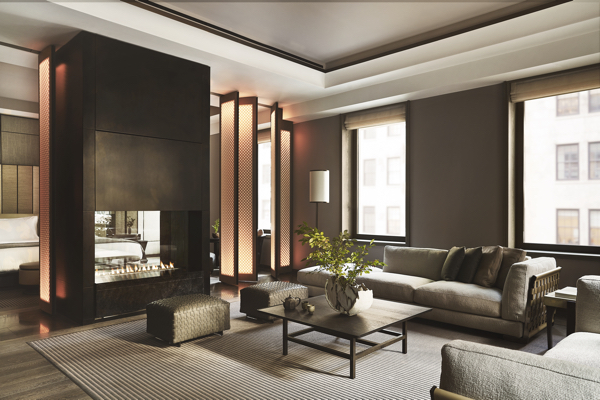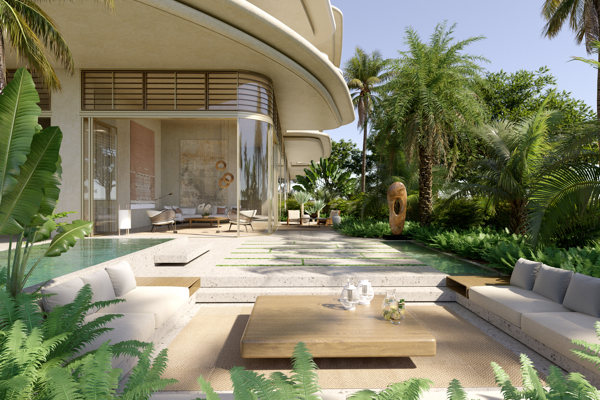Aman has been putting greater emphasis on urban resorts over the past five years and just now in the U.S. Vladislav Doronin’s ultra-luxury group is making perhaps its biggest impression yet. In early August it will finally open the Aman New York after earlier this spring signing a deal to operate in Beverly Hills, California, for developers Alagem Capital and Cain International at the high-profile, 17.5-acre One Beverly Hills development.
At Fifth Avenue and West 57th Street with views of Central Park, Aman New York, under development for seven years, occupies the top 20 floors of the iconic Crown Building and includes 22 exclusive residences atop the 83-room hotel. All but four of the condos are sold and sales really took off over the last 18 months, according to Aman COO Roland Fasel. A full-floor unit sold for a reported grandiose US$55 million (roughly US$8,730 per square foot).

Doronin’s OKO Group in July closed a US$754 million loan to refinance the New York property and is finally opening the doors with extraordinary pre-opening demand to the delight of Fasel and property Managing Director Rudy Tauscher.
Across the country in Los Angeles, the Aman hotel, branded residence and membership club are supposed to open in 2026 less than a mile away from Rodeo Drive shopping.
Aman now operates some 35 resorts and urban hotels in more than 20 countries, again with an increasing emphasis on city center opportunities. Aman Residences in Tokyo is expected to open next year along with Aman Nai Lert Bangkok, while Aman Miami Beach is set for 2024.
Fasel said Aman believes it is still underexposed in Italy and is very close on a deal or two there. He added that it would be beautiful to add properties in Africa and South America and move in further south of the Aman in Mexico City.
HOTELS recently spoke with Fasel to describe Aman’s direction and the significance of these two crucial urban developments in the United States.
HOTELS: What’s on your mind?
Roland Fasel: We are still in the middle of a very strong growth cycle. The pipeline is strong and there are nine hotels under construction and 20 at some sort of commitment level. I feel that’s about the magnitude of a pipeline we can absorb during the current structure… New York is opening August 2. Miami is coming, we have announced Beverly Hills, and Tokyo is coming in November 2023. The switch from resorts to an urban context is now very engrained in our strategy. Now it is coming through, and several others will be announced… That doesn’t mean we’re not looking for other exotic resorts – we’re still trying to get some over the line… The aspiration is to reach 45 to 48 hotels within the next few years, and it is still very much where we feel we can deliver.
We have also done the heavy lifting around Aman Essential – the retail business with spa products, clothing, active wear and more – and we will do more in the retail space around furniture.

The next important part of our brand extension is Aman at Sea. We have a signed deal with partners and it is a completely different business – from marketing to bookings and deposits. There is a lot of learning to be done there, but it’s exciting and I think it’s going to be quite a good story around expanding our brand.
We also continue to evolve with wellness, and we are very excited that Bhutan reopens in a few months, which obviously has been closed for so long.
H: How much equity is Aman putting into new deals?
RF: The aim is definitely asset light. But I am in a fortunate situation where I have an owner, developer and real estate specialist in the game who runs propco and obviously is involved in the Aman brand, intensely, and wants to have some skin in the game if necessary. So, I have from zero equity to 49% equity and 51% equity, depending on what makes sense. But it’s a huge advantage to be able to have the conversations… We have been able to grow over the last five, six years in those top locations because we have a chairman and owner who is willing to put skin in the game. That shows commitment and ability to empathize with the developer on the other side, and I think that’s been the key to our success.
The other huge success story surrounding Aman over the last five, six years is residential sales. With what we have in the pipeline plus inventory is about US$5 billion in real estate offerings. We have sold US$2.3 billion over the last 18 months or so, and that’s truly a huge component of our success… But you can only do it if you’re committed to staying on brand to keep delivering on the value propositions.
Miami residential is sold. Cabo San Lucas is pretty much all sold. Aman residences in Tokyo completely sold out in eight months with huge premiums. That story is very powerful. Bangkok is now becoming active, as well.
H: How many Aman at Sea are under development?
RF: Just one (with perhaps 50 cabins), and what makes it different is that we are going to run it – it’s not a licensing agreement… We are trying to stamp our values, our service proposition, and we are trying to get hotel employees involved in the service delivery. There is this cross-fertilization that could work beautifully.
We must differentiate. The ship is being designed by one our core designers. It’s the same mentality and focus on the details as the hotels with generosity of space, the ability to have the privacy, etc.
H: How important are New York and Beverly Hills to the growth and strength of the brand?
RF: My biggest market across the globe and across the portfolio is the American market – it’s 35% to 37%. So, I have always felt that Aman New York – what it will do for brand recognition and how much it will help as a feeder market – will be extraordinary. That’s why we must get it right, and I think the same will apply in Los Angeles… These gateway cities will be fundamental to our success and that’s why we switched into that strategy. It makes sense commercially. And having a few gateway cities, the income will be even greater than some of the resorts.
H: How long before you’re able to recover the investment in New York City?
RF: There were delays, as well as supply chain challenges and inflationary pressure. So, of course, you have a little bit more pressure on delivering those initial ROIs. But the reality is also that I feel we can push some of the rates, while I think our occupancy will not have a challenge. The value proposition in the New York market, based on initial inquiries and market research, will also go through the roof. So, now, coming out, the two may balance out… With the pent-up demand in New York, I really have an opportunity to place this property very quickly at the top of the market. The smallest room is 70-plus square meter, 730 square feet, literally competing against the suites. If you look at the occupancy levels today in New York and over the last few months – recovering very quickly – I’m cautiously optimistic that we won’t be that far off of what we initially forecasted.
H: What ADR do you think you’re going to get in New York?
RF: I need to get US$2,500. That’d be another minimum. If I get it right, I can even go a little bit higher.
H: What is Aman’s forecast for revenue growth?
RF: As a total brand, we’ll be ahead of 2019 numbers, which was our best year in history. In 10 to 15 of our hotels, we are reaching new heights around rates with little resistance, which has been extraordinary. I think that trend will continue for a little bit, but we need to be careful and really focus on the value proposition, so guests feel that we deliver against those rates.
The challenge is still Japan’s recovery – Tokyo. I still have challenges in Indonesia, where one hotel works well and the other three are really challenging… I think once Tokyo swings back and our Bhutan property reopens, we’re going to have a strong second half of this year. Then, in New York, I’m cautiously optimistic that as of September we will have four very, very strong months to really give us the momentum in 2023 to clearly position ourselves at the top of the New York market.

H: Can you share one or two of your biggest learns from the New York project?
RF: The takeaway is that I couldn’t have done this alone. It is crucial to bring together a cohesive, aligned team. To transform a building like the Crown Building to Aman standards, which implies certain ceiling heights, fireplaces, etc., and to deliver this in a New York context with the current state of affairs was extraordinary challenging… It’s one of those challenges which we will remember forever.. The takeaway is that you must stay calm and always tell people that within six to eight months we’ll only remember the good stuff. But this has been a challenge on so many levels that you don’t want to do too often in your career… It will be a marker for all our careers.
H: On a more global scale, are you tweaking your service delivery or adjusting amenities?
RF: We recognize the change of multi-generational travel; we understand that lead times are much shorter; and people want to have more space. Therefore, our villa product has gone through the roof. Even the tents at Amangiri have been a huge success… Wellness, where we can perpetually evolve, we are moving from being reactive to much more proactive in bringing in more technology to help guests stay healthy from the morning through the evening… You must have agility and creativity as the market changes. But I also believe some of this is just organic. And Aman products are actually becoming more relevant today than ever.
H: What has surprised you this year?
RF: I did not anticipate that we’d come back so quickly – that was surprising in a good way. The challenges around talent – I thought it was temporary, but I think we’re going to be in this for a long time before we re-stimulate an entire generation of talent to come into this business.
